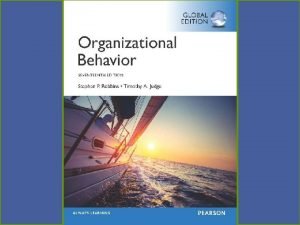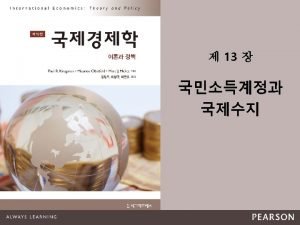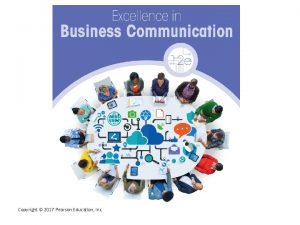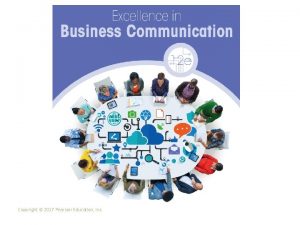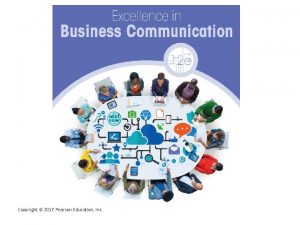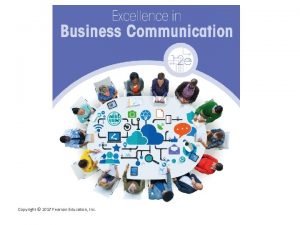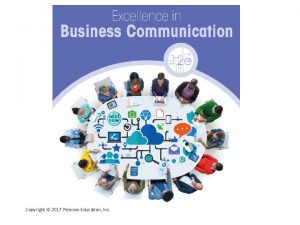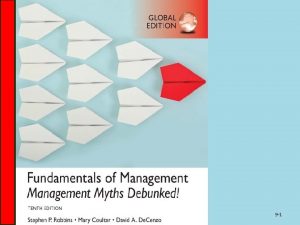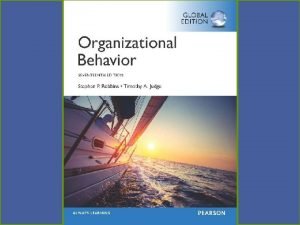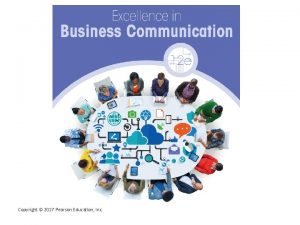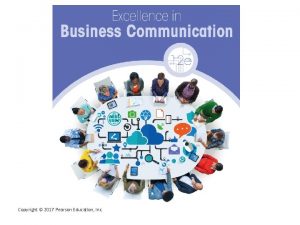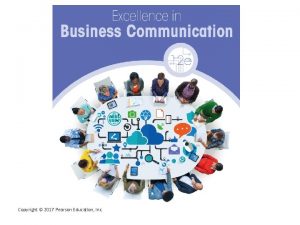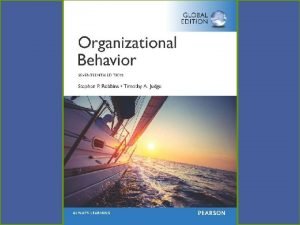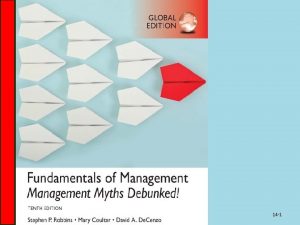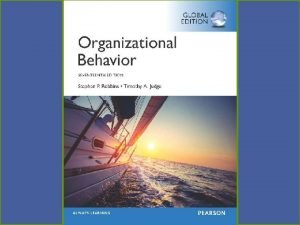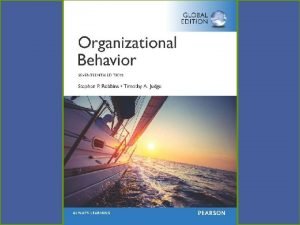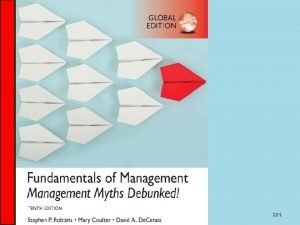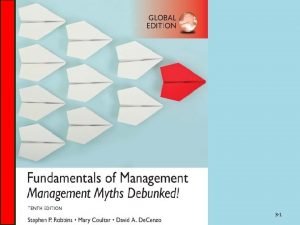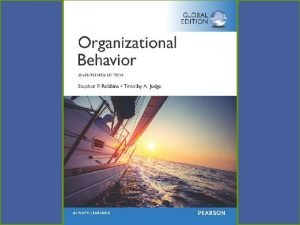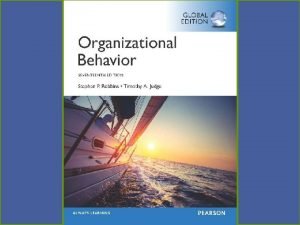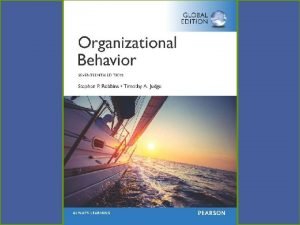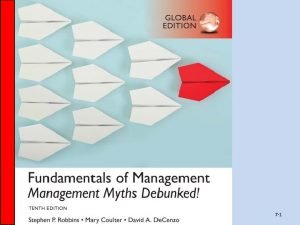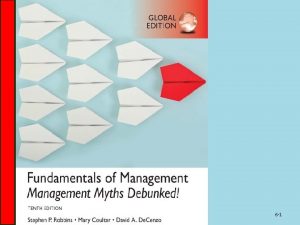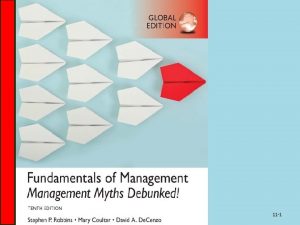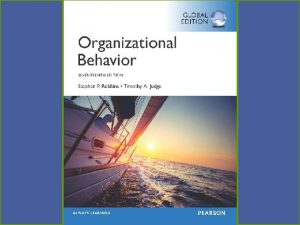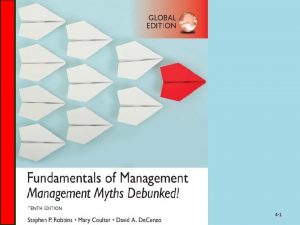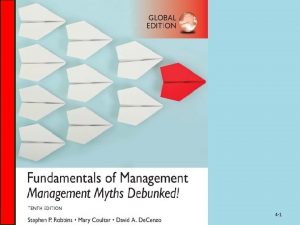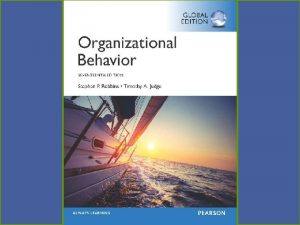Copyright 2017 Pearson Education Ltd 1 1 6




































- Slides: 36

Copyright © 2017 Pearson Education, Ltd. 1 -1

6 Perception and Individual Decision Making Copyright © 2017 Pearson Education, Ltd.

Learning Objectives q Explain the factors that influence perception. q Describe attribution theory. q Explain the link between perception and decision making. q Contrast the rational model of decision making with bounded rationality and intuition. q Explain how individual differences and organizational constraints affect decision making. q Contrast the three ethical decision criteria. q Describe three-stage model of creativity. Copyright © 2017 Pearson Education, Ltd. 6 -3

LO 1 Explain the Factors That Influence Perception ØPerception is a process by which individuals organize and interpret their sensory impressions in order to give meaning to their environment. ØIt is important to the study of OB because people’s behaviors are based on their perception of what reality is, not on reality itself. Copyright © 2017 Pearson Education, Ltd. 6 -4

LO 1 Explain the Factors That Influence Perception Copyright © 2017 Pearson Education, Ltd. 6 -5

LO 2 Explain Attribution Theory ØAttribution theory suggests that when we observe an individual’s behavior, we attempt to determine whether it was internally or externally caused. ØDetermination depends on three factors: Ø Distinctiveness Ø Consensus Ø Consistency Copyright © 2017 Pearson Education, Ltd. 6 -6

LO 2 Explain Attribution Theory ØClarification of the differences between internal and external causation Ø Internally caused – those that are believed to be under the personal control of the individual. Ø Externally caused – resulting from outside causes. Copyright © 2017 Pearson Education, Ltd. 6 -7

LO 2 Explain Attribution Theory Copyright © 2017 Pearson Education, Ltd. 6 -8

LO 2 Explain Attribution Theory ØFundamental attribution error Ø We have a tendency to underestimate the influence of external factors and overestimate the influence of internal or personal factors. ØSelf-serving bias Ø Individuals attribute their own successes to internal factors. Copyright © 2017 Pearson Education, Ltd. 6 -9

LO 2 Explain Attribution Theory ØCommon Shortcuts in Judging Others Ø Selective perception ØAny characteristic that makes a person, object, or event stand out will increase the probability that it will be perceived. ØSince we can’t observe everything going on around us, we engage in selective perception. Copyright © 2017 Pearson Education, Ltd. 6 -10

LO 2 Explain Attribution Theory ØHalo effect Ø The halo effect occurs when we draw a general impression on the basis of a single characteristic. ØContrast effects Ø We do not evaluate a person in isolation. Ø Our reaction to one person is influenced by other persons we have recently encountered. Copyright © 2017 Pearson Education, Ltd. 6 -11

LO 2 Explain Attribution Theory ØStereotyping Ø Judging someone on the basis of our perception of the group to which he or she belongs. Ø We have to monitor ourselves to make sure we’re not unfairly applying a stereotype in our evaluations and decisions. Copyright © 2017 Pearson Education, Ltd. 6 -12

LO 2 Explain Attribution Theory ØApplications of Shortcuts in Organizations Ø Employment Interview ØEvidence indicates that interviewers make perceptual judgments that are often inaccurate. ØInterviewers generally draw early impressions that become very quickly entrenched. ØStudies indicate that most interviewers’ decisions change very little after the first four or five minutes of the interview. Copyright © 2017 Pearson Education, Ltd. 6 -13

LO 2 Explain Attribution Theory ØPerformance Expectations Ø Evidence demonstrates that people will attempt to validate their perceptions of reality, even when those perceptions are faulty. ØSelf-fulfilling prophecy, or the Pygmalion effect, characterizes the fact that people’s expectations determine their behavior. ØExpectations become reality. Copyright © 2017 Pearson Education, Ltd. 6 -14

LO 2 Explain Attribution Theory ØPerformance Evaluation Ø An employee’s performance appraisal is very much dependent upon the perceptual process. ØMany jobs are evaluated in subjective terms. ØSubjective measures are problematic because of selective perception, contrast effects, halo effects, and so on. Copyright © 2017 Pearson Education, Ltd. 6 -15

LO 3 Explain the Link Between Perception and Decision Making ØIndividuals make decisions – choosing from two or more alternatives. ØDecision making occurs as a reaction to a problem. Ø There is a discrepancy between some current state of affairs and some desired state, requiring consideration of alternative courses of action. ØOne person’s problem is another’s satisfactory state of affairs. Copyright © 2017 Pearson Education, Ltd. 6 -16

LO 4 Rational Model of Decision Making vs. Bounded Rationality and Intuition Copyright © 2017 Pearson Education, Ltd. 6 -17

LO 4 Rational Model of Decision Making vs. Bounded Rationality and Intuition ØAssumptions of the Rational Model Ø The decision maker… ØHas complete information. ØIs able to identify all the relevant options in an unbiased manner. ØChooses the option with the highest utility. ØMost decisions in the real world don’t follow the rational model. Copyright © 2017 Pearson Education, Ltd. 6 -18

LO 4 Rational Model of Decision Making vs. Bounded Rationality and Intuition ØBounded Rationality Ø Most people respond to a complex problem by reducing it to a level at which it can be readily understood. ØPeople satisfice – they seek solutions that are satisfactory and sufficient. Ø Individuals operate within the confines of bounded rationality. ØThey construct simplified models that extract the essential features. Copyright © 2017 Pearson Education, Ltd. 6 -19

LO 4 Rational Model of Decision Making vs. Bounded Rationality and Intuition ØHow does bounded rationality work? Ø Once a problem is identified, the search for criteria and options begins. ØA limited list of the more conspicuous choices is identified. Ø The decision maker then reviews the list, looking for a solution that is “good enough. ” Copyright © 2017 Pearson Education, Ltd. 6 -20

LO 4 Rational Model of Decision Making vs. Bounded Rationality and Intuition Ø Intuitive decision making occurs outside conscious thought; it relies on holistic associations, or links between disparate pieces of information, is fast, and is affectively charged, meaning it usually engages the emotions. Ø The key is neither to abandon nor rely solely on intuition, but to supplement it with evidence and good judgment. Copyright © 2017 Pearson Education, Ltd. 6 -21

LO 4 Rational Model of Decision Making vs. Bounded Rationality and Intuition Copyright © 2017 Pearson Education, Ltd. 6 -22

LO 4 Rational Model of Decision Making vs. Bounded Rationality and Intuition ØCommon Biases and Errors in Decision Making Ø Overconfidence Bias: individuals whose intellectual and interpersonal abilities are weakest are most likely to overestimate their performance and ability. Ø Anchoring Bias: fixating on initial information as a starting point and failing to adequately adjust for subsequent information. Copyright © 2017 Pearson Education, Ltd. 6 -23

LO 4 Rational Model of Decision Making vs. Bounded Rationality and Intuition ØConfirmation Bias: type of selective perception. Ø Seek out information that reaffirms past choices, and discount information that contradicts past judgments. ØAvailability Bias: tendency for people to base judgments on information that is readily available. Copyright © 2017 Pearson Education, Ltd. 6 -24

LO 4 Rational Model of Decision Making vs. Bounded Rationality and Intuition ØEscalation of Commitment: staying with a decision even when there is clear evidence that it’s wrong. ØLikely to occur when individuals view themselves as responsible for the outcome. ØRandomness Error: our tendency to believe we can predict the outcome of random events. Ø Decision making becomes impaired when we try to create meaning out of random events. Copyright © 2017 Pearson Education, Ltd. 6 -25

LO 4 Rational Model of Decision Making vs. Bounded Rationality and Intuition ØRisk Aversion: the tendency to prefer a sure thing instead of a risky outcome. ØAmbitious people with power that can be taken away appear to be especially risk averse. ØPeople will more likely engage in risk-seeking behavior for negative outcomes, and riskaverse behavior for positive outcomes, when under stress. ØHindsight Bias: the tendency to believe falsely that one has accurately predicted the outcome of an event, after that outcome is actually known. Copyright © 2017 Pearson Education, Ltd. 6 -26

LO 5 Individual Differences, Organizational Constraints, and Decision Making ØIndividual Differences Ø Personality ØConscientiousness ØHigh self-esteem Ø Gender ØRumination Ø Mental Ability Ø Cultural Differences Ø Nudging Copyright © 2017 Pearson Education, Ltd. 6 -27

LO 5 Individual Differences, Organizational Constraints, and Decision Making ØOrganizational Constraints Ø Performance Evaluation Systems Ø Reward Systems Ø Formal Regulations Ø System-Imposed Time Constraints Ø Historical Precedents Copyright © 2017 Pearson Education, Ltd. 6 -28

LO 6 Contrast the Three Ethical Decision Criteria Ø Utilitarianism: decisions are made solely on the basis of their outcomes or consequences. Ø Focus on rights: calls on individuals to make decisions consistent with fundamental liberties and privileges as set forth in documents such as the Bill of Rights. Ø Protects whistle-blowers. ØImpose and enforce rules fairly and impartially to ensure justice or an equitable distribution of benefits and costs. Copyright © 2017 Pearson Education, Ltd. 6 -29

LO 6 Contrast the Three Ethical Decision Criteria ØBehavioral ethics: an area of study that analyzes how people actually behave when confronted with ethical dilemmas. Ø Individuals do not always follow ethical standards promulgated by their organizations, and we sometimes violate our own standards. Ø There are ways to increase ethical decision making in organizations. Ø Consider cultural differences. Copyright © 2017 Pearson Education, Ltd. 6 -30

LO 6 Contrast the Three Ethical Decision Criteria ØLying ØOne of the top unethical activities we may indulge in daily. ØIt undermines all efforts toward sound decision making. ØManagers—and organizations—simply cannot make good decisions when facts are misrepresented and people give false motives for their behaviors. ØLying is a big ethical problem as well. Copyright © 2017 Pearson Education, Ltd. 6 -31

LO 7 Describe the Three-Stage Model of Creativity ØCreativity is the ability to produce novel and useful ideas. Ø These are ideas that are different from what has been done before, but that are also appropriate to the problem. Copyright © 2017 Pearson Education, Ltd. 6 -32

LO 7 Describe the Three-Stage Model of Creativity Copyright © 2017 Pearson Education, Ltd. 6 -33

Implications for Managers ØBehavior follows perception, so to influence behavior at work, assess how people perceive their work. Often behaviors we find puzzling can be explained by understanding the initiating perceptions. ØMake better decisions by recognizing perceptual biases and decision-making errors we tend to commit. Learning about these problems doesn’t always prevent us from making mistakes, but it does help. Copyright © 2017 Pearson Education, Ltd. 6 -34

Implications for Managers ØAdjust your decision-making approach to the national culture you’re operating in and to the criteria your organization values. If you’re in a country that doesn’t value rationality, don’t feel compelled to follow the rational decisionmaking model or to try to make your decisions appear rational. Adjust your decision approach to ensure compatibility with the organizational culture. Copyright © 2017 Pearson Education, Ltd. 6 -35

Implications for Managers ØCombine rational analysis with intuition. These are not conflicting approaches to decision making. By using both, you can actually improve your decision making effectiveness. ØTry to enhance your creativity. Actively look for novel solutions to problems, attempt to see problems in new ways, use analogies, and hire creative talent. Try to remove work and organizational barriers that might impede your creativity. Copyright © 2017 Pearson Education, Ltd. 6 -36
 Pearson education ltd 2017
Pearson education ltd 2017 Copyright pearson education inc
Copyright pearson education inc Pearson education ltd 2017
Pearson education ltd 2017 2017 pearson education inc
2017 pearson education inc Copyright 2010 pearson education inc
Copyright 2010 pearson education inc Copyright 2009
Copyright 2009 Copyright pearson education inc
Copyright pearson education inc 2014 pearson education inc
2014 pearson education inc Copyright 2010 pearson education inc
Copyright 2010 pearson education inc Copyright 2010 pearson education inc
Copyright 2010 pearson education inc Copyright by pearson education inc. answers
Copyright by pearson education inc. answers 2008 pearson education inc
2008 pearson education inc Copyright 2009 pearson education inc
Copyright 2009 pearson education inc Copyright pearson education inc
Copyright pearson education inc Copyright 2010 pearson education inc
Copyright 2010 pearson education inc Copyright 2010 pearson education inc
Copyright 2010 pearson education inc Copyright 2010 pearson education inc
Copyright 2010 pearson education inc Copyright 2010 pearson education inc
Copyright 2010 pearson education inc Copyright 2010 pearson education inc
Copyright 2010 pearson education inc Copyright 2010 pearson education inc
Copyright 2010 pearson education inc Pearson education inc all rights reserved
Pearson education inc all rights reserved Copyright 2009 pearson education inc
Copyright 2009 pearson education inc Copyright 2009 pearson education inc
Copyright 2009 pearson education inc Copyright 2009 pearson education inc
Copyright 2009 pearson education inc Copyright 2009 pearson education inc
Copyright 2009 pearson education inc Copyright pearson education inc
Copyright pearson education inc 2017 pearson education inc
2017 pearson education inc 2017 pearson education inc
2017 pearson education inc 2017 pearson education inc
2017 pearson education inc 2017 pearson education inc
2017 pearson education inc 2017 pearson education inc
2017 pearson education inc Pearson education 2017
Pearson education 2017 2017 pearson education inc
2017 pearson education inc Pearson education 2017
Pearson education 2017 2017 pearson education inc
2017 pearson education inc Nine compositional modes in digital media
Nine compositional modes in digital media 2017 pearson education inc
2017 pearson education inc
